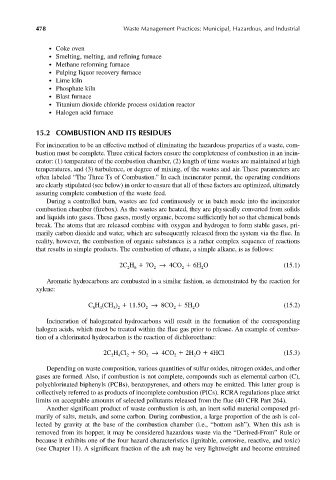Page 507 - Materials Chemistry, Second Edition
P. 507
CAT3525_C15.qxd 1/27/2005 12:40 PM Page 478
478 Waste Management Practices: Municipal, Hazardous, and Industrial
● Coke oven
● Smelting, melting, and refining furnace
● Methane reforming furnace
● Pulping liquor recovery furnace
● Lime kiln
● Phosphate kiln
● Blast furnace
● Titanium dioxide chloride process oxidation reactor
● Halogen acid furnace
15.2 COMBUSTION AND ITS RESIDUES
For incineration to be an effective method of eliminating the hazardous properties of a waste, com-
bustion must be complete. Three critical factors ensure the completeness of combustion in an incin-
erator: (1) temperature of the combustion chamber, (2) length of time wastes are maintained at high
temperatures, and (3) turbulence, or degree of mixing, of the wastes and air. These parameters are
often labeled “The Three Ts of Combustion.” In each incinerator permit, the operating conditions
are clearly stipulated (see below) in order to ensure that all of these factors are optimized, ultimately
assuring complete combustion of the waste feed.
During a controlled burn, wastes are fed continuously or in batch mode into the incinerator
combustion chamber (firebox). As the wastes are heated, they are physically converted from solids
and liquids into gases. These gases, mostly organic, become sufficiently hot so that chemical bonds
break. The atoms that are released combine with oxygen and hydrogen to form stable gases, pri-
marily carbon dioxide and water, which are subsequently released from the system via the flue. In
reality, however, the combustion of organic substances is a rather complex sequence of reactions
that results in simple products. The combustion of ethane, a simple alkane, is as follows:
2C H 7O → 4CO 6H O (15.1)
2
2
2
6
2
Aromatic hydrocarbons are combusted in a similar fashion, as demonstrated by the reaction for
xylene:
C H (CH ) 11.5O → 8CO 5H O (15.2)
2
4
6
3 2
2
2
Incineration of halogenated hydrocarbons will result in the formation of the corresponding
halogen acids, which must be treated within the flue gas prior to release. An example of combus-
tion of a chlorinated hydrocarbon is the reaction of dichloroethane:
2C H Cl 5O → 4CO 2H O 4HCl (15.3)
2 4 2 2 2 2
Depending on waste composition, various quantities of sulfur oxides, nitrogen oxides, and other
gases are formed. Also, if combustion is not complete, compounds such as elemental carbon (C),
polychlorinated biphenyls (PCBs), benzopyrenes, and others may be emitted. This latter group is
collectively referred to as products of incomplete combustion (PICs). RCRA regulations place strict
limits on acceptable amounts of selected pollutants released from the flue (40 CFR Part 264).
Another significant product of waste combustion is ash, an inert solid material composed pri-
marily of salts, metals, and some carbon. During combustion, a large proportion of the ash is col-
lected by gravity at the base of the combustion chamber (i.e., “bottom ash”). When this ash is
removed from its hopper, it may be considered hazardous waste via the “Derived-From” Rule or
because it exhibits one of the four hazard characteristics (ignitable, corrosive, reactive, and toxic)
(see Chapter 11). A significant fraction of the ash may be very lightweight and become entrained

